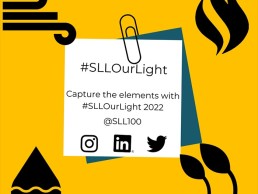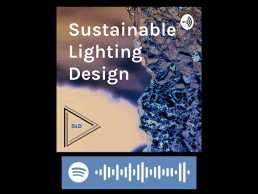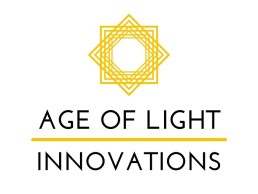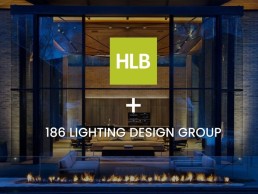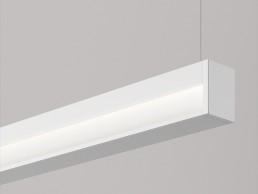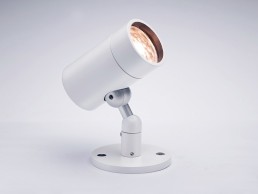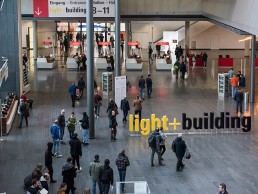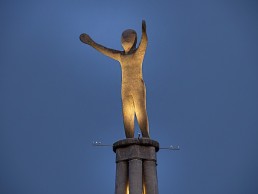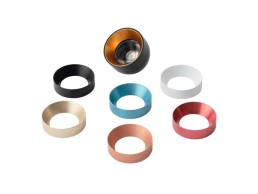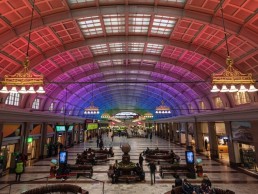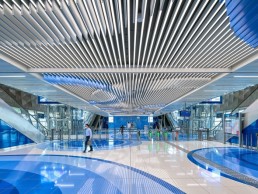SLL’s #SLLOurLight social media campaign returns
(Online) - Originally launched in March 2021, #SLLOurLight is returning from 14-31 January 2022.
Led by the Society of Light and Lighting (SLL), #SLLOurLight is a social media campaign designed to provide an opportunity to celebrate light and lighting from wherever you are in the world. The these for this year’s campaign is the interplay between light and the four elements - Earth, Wind, Fire and Water.
Open to all, the SLL is inviting people to post images on Instagram, Twitter and/or LinkedIn using the tag #SLLOurLight. “#SLLOurLight originally came as a response to the lack of face-to-face events, due to the coronavirus pandemic. The SLL wanted to find a way to bring the lighting community together virtually,” the association said.
“In considering themes for this year’s #SLLOurLight, the Society wanted to ensure that everyone could get involved, whether it’s a ripple on the surface of a pond or a cosy winter scene by the fire, we’d like to hear from you. You can create a lighting installation inspired by the elements, or just capture something that you think reflects the interplay between light and one or more of them.”
Following the closing date on 31 January, the SLL will select a winning picture from each platform. The Society is inviting anyone and everyone to take part, with the aim of having fun and celebrating the lighting community together online.
More information on the competition, including terms, can be found here.
Sustainable Lighting Design podcast passes 1,500 listeners
(Online) - A new podcast dedicated to sustainability and wellbeing in the lighting design process has surpassed 1,500 listeners.
The show, titled Sustainable Lighting Design, is led by Isabel Villar and Maha Shalaby, lighting designer and architect and sustainability specialist respectively at White Arkitekter in Stockholm, Sweden. Villar and Shalaby hope that the podcast will act as an “interdisciplinary ‘Research in Practice’ project, challenging the status quo of lighting design”.
To date, the show has released seven episodes, covering a variety of key topics within the lighting design field; from daylighting and protecting the dark sky, to circularity, WELL certification and Chronobiology - with each episode featuring an expert guest.
All episodes are available to listen to on Spotify here.
Zumtobel sponsors Luna Pro Project
(Online) - Zumtobel has announced that it is sponsoring the Luna Pro Project, spearheaded by Founder and Managing Director of Age of Light Innovations, Dr Shelley James.
Dr Shelley is an advocate for educating on healthy lighting for people, profit, and the environment. The original Luna social media campaign was a huge success and raised awareness of the impact of light on health and wellbeing. It has reached more than 2.5 million teenagers around the world to-date. The Luna Pro project now makes the business case for healthy lighting, bringing together key industry players from manufacturers and industry bodies to academics.
The project has been running for eight months so far, covering four key sectors (healthcare, education, residential, and workplace). Momentum is increasing with sixteen interviews conducted and eight events and webinars held within and beyond the lighting sector.
The campaign has welcomed an outstanding level of support from organisations such as Great Ormond Street and Arup.
Dr. Shelley James commented: “It's a privilege to work with Zumtobel to build bridges beyond the lighting sector and engage with end-users on their terms. Together, we are raising awareness of the potential of lighting to build a healthier, more sustainable and productive world”.
Matthew Boucher Managing Director at Zumtobel Group UK & Ireland added: “We are finally starting to think about light in a new way and recognising the benefits it can have on performance and wellbeing. Dr Shelley’s work aligns with our belief that the right light at the right time can be hugely beneficial, not just in terms of true colour representation but for all our health, wellbeing, and development. In terms of life span, the Luna project is still in its infancy, but we can already see the value and speed with which it is being adopted. We are looking forward to collaborating and working with Dr. Shelley and seeing where this journey ends and the far-reaching effects that can be made possible.”
www.ageofinnovations.com
www.z.lighting
Silhouette Awards winners to be announced
(Global) – The inaugural Silhouette Awards will announce its winners this month.
The event will take place virtually on 31 January, where this year’s 20 winning mentees will be announced along with who their mentors for the programme will be.
Curated my Parrot PR and Archifos, the Silhouette Awards programme will be focused on identifying the lighting industry’s rising stars and subsequently supporting these young professionals beyond as they progress their careers.
The event is supported by an international panel of judge mentors, who are all highly respected individuals within the lighting industry. These judges will not only select the 20 winners, from all entrants into the Silhouette Awards, but will then formally partner with one of them as their industry mentor for the following six months. Each partnership will be supported by a sponsor.
The Silhouette Awards aims to provide a platform to showcase young industry talent offering much-deserved recognition and publicity for the achievements of all under 35’s to date – and provide the winners the opportunity to learn from some of the very best in the industry.
More information on the awards presentation will be announced on the Silhouette Awards social media channels (@silhouetteawards).
186 Lighting Design Group joins HLB Lighting Design
(USA) - HLB Lighting Design has announced that Denver-based 186 Lighting Design Group has joined the firm.
The move has created substantial value for both firms, representing a strategic growth opportunity for HLB, while providing expanded company infrastructure and market sector development for 186.
The 186 team specialises in high-end residential lighting design, bringing this market sector to the forefront for the first time in HLB’s 53 years of business. 186 has completed projects across North America and the Caribbean, in destinations such as Aspen, Maui and St Lucia.
Gregg Mackell, Principal at 186, joins HLB with more than 28 years of experience and over a thousand projects on his resume. “The integration of 186 Lighting Design Group into HLB feels like a natural fit. Our design philosophies mesh well and the opportunity to join a world-class design team will allow us to expand with increased quality and unlimited creativity,” he said.
Carrie Hawley, Senior Principal and CEO of HLB, added: “This merger is a fundamentally great union given our shared values, primary focus on our people, passion for excellence and aligned vision for the future. We are thrilled that our combined talents will provide even more value to all of our clients moving forward.”
Darkon Wyn It
Wyn It is an indirect luminaire configurable to required length, with an asymmetrical light distribution suitable for surface-mounted, suspended and recessed applications, making it ideal for wall, ceiling or floor washing applications of all types. It features an easy install mounting box (or profile with trim for recessing) and an integrally located driver. Architecturally designed with no visible fixings, the curved internal reflector delivers high lumen output with low glare making this a highly versatile inclusion for all lighting designs.
Stoane Lighting ZTA.35
ZTA.35 is the latest addition to Stoane Lighting’s Circular Economy focussed product line-up. The smallest in the range at Ø35mm offers up to 700lm delivered. There are a wide range of dedicated optics to choose from depending on your source. It can also come with a zoom lens that rotates seamlessly from narrow to flood. True to ZTA form, it is flexible in choice of finish, control and mount type.
Light + Building 2022 moves to October
(Germany) - Organisers of Light + Building have announced the decision to postpone the 2022 event, originally scheduled for 13-18 March, until the Autumn.
Last December, intensive discussions with customers and event partners caused the show to look at alternatives to the original dates, and now a decision has been reached to hold the show from 2-6 October 2022.
“We took the concerns of our partners very seriously, and of course also weighed up the entrepreneurial opportunities and risks. As already announced in December, all options for a new date were under review. Fortunately we managed to find an attractive autumn date and make it possible through internal rescheduling for Light + Building. This means that the prospect of a strong, international sector launch in Frankfurt in 2022 remains,” said Wolfgang Marzin, President and CEO of Messe Frankfurt.
The move comes as Covid-19 figures saw an increase in Germany following the appearance of the Omicron variant, while associated travel restrictions led to uncertainty within the lighting, building and safety technology sector.
GreenLight Alliance: Hope For The Future
Created for the COP26 climate conference by Steuart Padwick with lighting designed by Buro Happold, Glasgow’s Hope Sculpture spotlights the global goals of the event with a 75% lower carbon build.
The Hope Sculpture started as a conversation with Ramboll and became a gift from 50 companies to Glasgow. It is a testament to the power of collaboration and dedication to deliver a better future” - Steuart Padwick.
In terms of its lighting aspects, the Hope Sculpture project is one of the first to incorporate both CIBSE TM65 and TM66 assessments for the lighting equipment utilised.
Concepted, designed and led by artist Steuart Padwick, the Hope Sculpture is a new permanent public art installation situated in the natural landscape of Cuningar Loop, part of Clyde Gateway, Scotland’s biggest and most ambitious regeneration programme. Visible from long and short distance views, the 23-metre tall sculpture rises above the woodland, overlooking River Clyde. The sculpture is topped by an age/gender/race neutral child figure with their arms reaching out to a greener, hopeful future.
Linked to the 2021 United Nations Climate Change Conference (COP26), the sculpture was constructed using low carbon, reclaimed, recycled or sustainable materials, of which, almost all have been locally sourced. It is a showcase for how leading industry partners are committed to build more sustainably, as we transition to a net zero future. The build demonstrates a 75% lower carbon impact.
The Hope Sculpture aims to raise awareness of the fragility of both our environment and our mental health and the importance of our natural environment and community in supporting our mental wellbeing.
The Hope Sculpture, alongside the Beacon of Hope and Hope Triptych, is part of a trilogy of urban installations situated at key locations across Glasgow. Buro Happold Lighting was approached by artist Steuart Padwick to work as part of the team and to provide a sensitive and environmentally conscious lighting design scheme for the night-time illumination, respecting the natural context. The fundamental question on the need to apply lighting was among our initial conversations with the artist. Over time and as the hosting environment for each installation was defined, it was agreed that the Beacon of Hope and Hope Triptych will not receive dedicated illumination as the ambient light conditions were deemed bright enough to support viewing the installations and additional lighting would need to compete with surroundings. Therefore, the following information focuses on the illumination of the Hope Sculpture on Cuningar Loop.
Design Narrative
From the design to the construction techniques and implementation delivery, the primary design principle was to promote sustainability and environmental care with the aim of a reduced carbon build. The following key strategies were followed on a project wide basis:
• Collaboration with local consultants, suppliers
• Use of reclaimed materials (i.e recycled gas pipes for the piling)
• Use of existing upcycled equipment/ samples
• Use of materials with low embodied carbon content (e.g. 100% cement-free concrete)
• Use of construction processes with low carbon footprint
Working as a team and with sustainability embedded in every aspect of the project, we strived to promote the fulfilment of delivering something new through the creative reuse/repurpose/upcycling of existing materials and sustainable manufacturing/construction processes.
Key Materials
The bespoke cement-free product has been developed by the Aggregate Industries’ technical experts in close partnership with the project team. This high strength product is part of their ECOPact Max green concrete range and reduces the carbon footprint by more than 70% compared to a standard concrete mix. Also incorporated in the concrete mix is recycled steel rebar. The cement-free concrete mix utilises a local Duntilland Dolerite aggregate and sand, and the cast child includes 20% recycled glass aggregate from Dryden Aqua, who recycle about a quarter of Scotland’s glass.
The Lighting Approach
At Buro Happold, we strive for our designs to be sustainable, sensitive towards nature and to contribute positively to climate resilience. As individuals, we are curious and conscious of our footprint paved by our design decisions. This leads to research and systematic actions supporting Buro Happold’s sustainability framework and commitments.
Exterior lighting is a considerable contributor in the energy demands of the built environment. If not designed appropriately, lighting has adverse effects on climate resilience. Despite its undoubted benefits, uncontrolled lighting creates light pollution. In turn, light pollution results in a chain effect including energy wastage, disruption of ecosystems, season shifting and effects on human physical and mental health. In alignment with the project’s ethos and with sustainability at the forefront of our lighting principles, we designed the lighting for the Hope sculpture with respect to the natural environment and our planet. We utilised programmable light sources of low power and high efficacy, reducing the operating demands. We sought to use existing or re-purposed lighting equipment from local Scottish manufacturer Stoane Lighting, minimising embodied carbon emissions. The equipment’s small scale, premium built quality, interchangeability of components and the commitment for future service of components contribute further to reducing direct and collateral embodied carbon aspects of the lighting installation and the project in total whilst enhancing the equipment’s advanced circularity.
Reminiscent of the chimney stalks that once littered the East End of Glasgow, Steuart Padwick’s deconstructed chimney design is made of six elegant, angled columns, creating a dramatic 20-metre high pedestal for the child of hope. The base of the sculpture is paved using locally quarried Caithness stone slabs with engraved poems and words delivering messages of hope. Linking our built environment with improved mental wellbeing, the artist worked with Mental Health Foundation on all messaging. Words of Hope have been written by some of Scotland’s favourite voices, writers and poets. Four monolithic stone benches are placed around the sculpture, allowing people to sit, rest and reflect.
The need for environmentally considerate night-time illumination of the sculpture was part of our brief. As the hosting environment is a relatively dark context, we did not need to apply a high intensity of light to ensure sufficient illumination. Conscious of the light wastage and given the height of the structure (23-metres above ground level), we excluded the conventional way of uplighting from ground level via recessed luminaires. Instead, the child figure is illuminated using miniature adjustable luminaires integrated on outreach brackets and mounted on the capping plate carrying the child figure. The multiple small-sized luminaires with low output and tight optics provide flexibility in adjustment for uniform illumination of the organic form, while minimising light spillage towards the night sky. The pillars are illuminated via a single downlight housed on the joining surface at the top of the columns with downward light emission and narrow optics. As the light reaches the ground, it creates a soft shadow-play in a star shape generated by the casting shadows of the surrounding pillars.
The lighting is warm white (3000K), dimmable, controlled separately and does not operate overnight. All control components are housed remotely in an overground feeder pillar for easy access and future maintenance visits.
The Sustainability Calculation Methodologies
The Hope Project lends itself as an ideal opportunity for our scheme to be assessed using two sustainability metrics: CIBSE TM 65, Embodied carbon in the MEP equipment, 2021; and CIBSE TM 66, Circular economy in the lighting industry, 2021 (Beta version of CEAM-Make).
These technical memorandums describe two different calculation methodologies; one focusing on the embodied carbon on a product level and the other of the circularity aspects of the product.
TM65 has not been widely used for the assessment of luminaire products yet. TM66 was formally released in Q4 2021 but luckily, we had access to an early beta version of the calculation tool (CEAM-Make) that enabled Stoane Lighting to input product information and supporting evidence.
The TM65 calculation took into account all luminaires and control components. The calculation method is based on total weight of the assessed system and material composition. The total estimated carbon emissions are 90kg CO2e. This figure reflects the worst case scenario as the drivers have been considered as an electronic component in their entirety and therefore bearing high embodied carbon content for their total weight (embodied carbon coefficient: 49kg CO2e/kg). Therefore, having the breakdown of the material composition of the driver component would have resulted in lower embodied carbon content of the total system. At the time of the calculation, the driver composition information was not available, highlighting the need to encourage lighting manufacturers and control component suppliers to take action now. Ultimately, having the base information publicly available will reduce the time required for the calculations to be performed and offer a more accurate impression of the performance of the system.
TM65 and TM66 cannot be compared or characterised as more/ less complete as they are used for assessing different aspects. However, as TM66 is solely focusing on assessing lighting equipment, the calculation method is more detailed and specific to the manufacturing, materials and processes associated to lighting. The products are assessed under four main categories: Product Design, Manufacturing, Materials and Ecosystems. Through a series of questions for each category, the lighting manufacturer is asked to give a rating (from 0-4) based on the level of evidence at hand and action towards a circular economy. Points are collected for each category and summed up reflecting the overall performance of the product. Lastly, using a simple traffic light system, the score reflects the level of circularity of the product. The lighting equipment utilised for the Hope Sculpture ranks within the ‘Excellent circularity’ range (2.5 to 3.5) scoring 2.7.
The above findings were fed into the project-wide sustainability assessment led by Ramboll, one of the key supporting partners along with Glasgow City Council, South Lanarkshire Council and Clyde Gateway.
Next Steps
The project offered us a great opportunity to test the above sustainability metrics in a real project. Throughout the process, we engaged with our collaborators to source the information required. As the lighting industry is at the early stages of development on these aspects, there is plenty of room for improvement on all fronts. This project will remain as a reference point in our ongoing endeavours to design, specify and provide consultancy services towards sustainable and considerate projects. Our next steps include continued engagement with forums, manufacturers and clients and including carbon and circularity input in our project deliverables.
Since the installation’s completion, all project collaborators have discussed the positive impact of the piece.
Steuart Padwick said: “We all need to address this new global agenda so our young can embrace a future of hope. It is very simple, why would anyone want to poison their future?”
Natalie Alexopoulos, Hope Project Director, added: “The most remarkable thing about this project has been collaborating with these companies and individuals. Their integrity, drive and commitment to make a difference has been inspiring.”
This series is curated by Roger Sexton of Stoane Lighting, roger@mikestoanelighting.com
David Morgan Review: Tryka SPA
During [d]arc room pop-up earlier this year, Tryka launched the SPA collection. Following its launch, David Morgan took a closer look at the range.
A lighting company with a memorable but unusual name, Tryka, that amalgamates characters from Tri colour (for RGB) with those from the founder’s children, is in the process of expanding its product ranges.
Tryka has established an international presence as a successful manufacturer of linear lighting systems and is now diversifying into a broader product portfolio with the introduction of the new SPA range.
Tryka was founded by Chris Rolph in 2002, who had worked for a number of other lighting companies, including Laser Graphix and latterly for CoeTech, where he was sales director.
The launch Tryka products included a 1200mm 36W linear product, a 36W PAR 56 projector, and 3W 50mm downlight module, which were followed by flexible modules, these are all products that remain staples of the current product portfolio.
‘Inspiration for your imagination’ was the original Tryka mission statement and the company believes it continues to encapsulate that approach based on working closely with lighting specifiers and customising products to meet project requirements.
The company employs 45 staff in two locations. Headquarters and production facilities are based in the UK and this operation is supplemented with a Middle East sales office in Dubai. Working with sales partners around the world, the major markets for Tryka include the Middle East, Europe, UK and the USA.
The new SPA range was launched at [d]arc room pop-up @ Design London in September 2021 and is aimed at the hospitality market, with hotel guest rooms as a particular target.
The central products in the SPA range are two sizes of downlight: 50mm and 70mm with fixed and adjustable versions but the presentation that I was sent as part of the review material illustrates a much wider product range and includes pendants, spotlights, task lighting, and many other luminaire types.
It is understood that an underlying concept for the development of the SPA range was based on the perception that lighting designers are keen to specify luminaire types for hotel guest rooms that all use a common light source and common aesthetic, but with a wide range of finishes and colours. From a lighting design perspective this approach makes good sense as it will help to minimise any discrepancies in light source colour temperature, CRI, and binning. While downlights generally share a common appearance, it may be a product development stretch to satisfy the diverse visual requirements of interior designers for the other luminaire types, such as table lamps and wall sconces.
The heart of the SPA range are the light engines and associated optics. These are designed so that the lighting specifier can select precisely the right light engine for the project in terms of performance and budget. The highest rated LED source is the Seoul Semiconductor Sunlike with a CRI of 97+. For less demanding projects, light sources from Cree, Bridgelux, and Luminus can be provided.
Similarly, the optics range from the Ledil Hekla COB holder with swappable lenses up to the digitally controllable LensVector liquid crystal lens that I have described in my reviews over the past couple of years. I am not sure if there is any level of hotel guest room being conceived yet for LensVector equipped downlights, but when that specification is written then Tryka will be ready. Beam angles available with the Ledil lenses and reflectors range from a narrow 10° up to 120°.
The sample SPA 50 downlight that I was sent to review was fitted with the Seoul Semiconductor Sunlike light engine, medium beam optic and a satin gold cone. The lit performance was unremarkable without any striations in the beam and would work well in all typical applications. The housing was machined from solid aluminium with a good quality powder coat finish for the body and trim and well finished satin gold anodised finish on the reflector. While the solid aluminium metal work provided a reassuringly heavy quality impression and would provide good thermal management, despite the lack of any finning, I wondered if the production costs would fit into the budgets allocated for guest room fixed downlights – even for 6- or 7-star hotels. It is understood that the design of the machined components fits into a circular economy model to allow them to be reused at some point in the future to produce new luminaires.
In order to replace the COB light engine at the end of life in the review sample, the downlight would need to be removed from the ceiling and disassembled but in full production this detail may be changed to allow COB changing from below the ceiling.
The SPA project appears to be a work in progress as only a limited range of luminaires illustrated in the presentation were shown at
[d]arc room. It will be interesting to see how the product range develops in the future to meet the project requirements of lighting designers and interior designers.
The SPA project was led by Ryan Rolph, Sales and Technical Director at Tryka, with the initial range design, including the light engine concept, provided by Simon Fisher at F Mark. The Tryka design and development team then progressed the design into the wider range of products which all incorporate the SPA light engine.
The design and development stages took around a year up to [d]arc room and it is understood that the most demanding engineering challenge was ensuring high efficiency combined with good visual comfort and a perfect lit effect.
As this is a new product introduction, there are no project references yet but it is understood that feedback from the lighting specification community has been positive and supportive of the SPA concept.
Stockholm Central Station, Sweden
For the newly designed lighting of Stockholm’s Central Station, Light Bureau sought to pay tribute to the site’s landmark status, while bringing the grand hall back to life.
With more than 200,000 visitors passing through each day, Stockholm Central Station is one of the busiest transport hubs in Sweden. Listed as a “building of national interest” - the highest grade of listing in the country - the station has been one of the first things that travellers into the city see for the past century.
While the station was first inaugurated in 1871, its grand central hall was first opened in 1927. It has since undergone a number of renovations and updates as its functions have grown and changed. Most recently the station has had a revamp of its lighting scheme, courtesy of Light Bureau, which was tasked with creating a new design that would balance respect for the original architecture with the commercial requirements of the space, and the needs of the passengers passing through.
Light Bureau won the lighting of this landmark project with proposal that Kai Piippo, Head of Design, described as “classic architectural lighting design”.
“There are only three light characters - general lighting, uplighting and accent lighting - so it’s a very simple concept, but it took us five years to complete because a lot of what seems simple at first is not, it took a lot of testing and a lot of hard work,” he explained.
Once the team had won the competition for the relighting, the assignment for the project began with extensive surveys of visual conditions, historical lighting and building appearance, analysing the existing lighting installations within the grand hall and the current functions of the space. During these studies, it was determined that the existing lighting was far below the requirements of the space, with levels as low as 65lx at night, with very little contrast or accent lighting.
However, one of the original features of the hall is a series of ornate, golden lamps called “Luzette”, that are suspended below the arched ceiling. As part of the renewed lighting, Piippo wanted to bring these beautiful pieces back to life, to reinvigorate the accent lighting within the space.
“When the station was first constructed, there were these beautiful lamps that were designed by the architect who built the hall in the 1920s. They had incandescent light sources in them, and after dark they were the only electrical light sources in the station. During the day there was daylight coming in from above and from the side, and then these beautiful, golden luminaires,” he said.
“In the 1950s, fluorescents came in, so they took the light sources away from the Luzette and went with fluorescent lighting along the side of the hall. In the 1990s, they were reconstructed by two lighting designers who redeveloped them and restored them, but they installed compact fluorescents in them, so you couldn’t see the golden upper part of the luminaire at all.
“We wanted to do something special with them, and we came up with an idea when we saw a low sunrise coming in, shining on the lanterns so that they really glowed. It was a wonderful, perfect light character. So we did a lot of light tests, and integrated some linear LEDs pointing upwards, finished in gold, so that they blended into the fixtures and brought them back to life.”
To improve the general lighting of the space - what Piippo referred to as the first “light character”, new ambient lighting was installed along both sides of the station’s central skylight. The aim was to reduce visual and physical disturbance on the ceiling by using small fixtures with a sharp cut-off. A combination of medium and narrow beam luminaires with DALI control allows for more varied contrast and light distribution, as well as the ability to highlight the station hall’s three event areas.
The second “light character”, the uplighting of the vast, arched ceiling, was intended to, in Piippo’s words, “create a hug of light”. “We wanted the ceiling to hug the people, and show the glory of its construction,” he said.
The uplighting incorporates DMX-controlled linear RGB fixtures and white fixtures in warm and cool white, mounted discreetly to the edge of the building to dramatically light up the spectacular ceilings. The introduction of coloured lighting allowed for the installation to be programmed with everyday static or slowly dynamic scenes, with additional, eye-catching displays for special occasions.
“I wanted to add a little bit more to the space,” Piippo explained. “I wanted the station to not only be a beautiful space. On a normal day, 200,000 people go through here, it’s the busiest place in Stockholm. The first time people come here, this is what they are greeted with.
“I thought about ways that we could use the light within the space to manifest the message of ‘Welcome to Stockholm - the capital of Sweden’. So we proposed to the company who owns the space that they could use the station to highlight occasions such as Christmas, Swedish National Day, Easter, and so on.
“One of the biggest things for me is to create a sense of value for the client, so that they know they are getting a good investment. We had 10 different scenarios programmed in that they can choose from, and then if there is anything - an event, etc - we can help them to create whatever they want with the system. We wanted to give them a system that is rich, that gives them something more.”
Throughout the project, Piippo, Project Leading Lighting Designer Karolina Hahn, Senior Lighting Designer Andreas Ejhed and Technical System Specialist Fredrik Winqvist worked in very close cooperation with the project leaders to create a solution that would showcase the splendour of the site while creating a warm and inviting space for travellers passing through. The team also made extra efforts to speak to the people that would be using the space the most, to give them what they want.
“One of the first people that we met was the maintenance manager of the station,” Piippo said. “He has been working there for 20 years or so, and he knows everything about the site. We interviewed him and asked him about what we should do and should not do. He said it needs to be easy to control, easy to access the controls, so we took this into consideration as he is someone that will actually live and work with the lighting. This is a key part of my design process - you need to have the knowledge about the daily use.”
This attention to detail has led to the creation of a new lighting scheme that fills the space with light in a considered, subtle way. Showcasing the architecture and creating a welcoming, inviting space for those using the space - with light levels now measuring up to 700lx, ten times what was previously there. With Stockholm’s varied light levels throughout the year, the new scheme also has an improved daylight control system for the general lighting, meaning that in the summer months where daylight is more abundant, the general lighting dims down, saving energy in the process.
“It’s very good to have,” Piippo added. “With everything going on at the moment, it’s not a ‘nice to have’ to think about the environment, it’s a ‘need to have’. It’s a key issue to use as little energy as possible.”
Looking back on the project now, Piippo explained that, with the Central Station having the status that it does within the city of Stockholm, he couldn’t help but feel the pressure to get the new lighting scheme right. However, his experience of working within heritage buildings means that he was able to find a solution that would work.
“You do the Central Station in Stockholm once in your lifetime, and you put that pressure on yourself,” he said. “But because of this project, and several others, I have become a specialist in historical projects. It’s super interesting to understand the process and the pros and cons of how to make it a successful project. There are a lot of different things to take into consideration, but it’s interesting.
“Going into the station now, it’s a simple lighting design, but it’s a beautiful space to be in; it’s inviting and welcoming. I’m very happy and proud to go there. The building managers are using the different scenarios, and you see it a lot on Instagram, etc.
“Before, it was dark and dull and boring, but now it is a beautiful space, it has come alive again.”
Dubai Route 2020 Metro Link, UAE
To mark the arrival of Expo 2020, the Route 2020 Metro Link project is an extension of Dubai’s metro line that welcomes visitors to the Expo site. Lighting for the station extensions came from dpa lighting consultants.
The Route 2020 Metro Link project from Dubai Roads and Transport Authority sees an extension of the Dubai metro service, connecting the interchange at Jebel Ali with the flagship metro station at the Expo 2020 site. Consisting of a 15km extension – of which approximately 12km is above ground and 3km underground – it features seven stations and branches from the existing Red Line.
dpa lighting consultants was approached by the architect Atkins (as part of the original Metro Bid team) to be involved in the project. Responsible for the design and specification of all architectural lighting to the interiors, façades, and landscape for all six new stations and the one existing interchange, the project presented the team with a number of unique lighting challenges, as Lee Sweetman, Director at dpa lighting consultants, explained to arc: “Several challenges presented themselves at each stage of the process, from the differing design languages of each station through to the integration and ongoing maintenance of appropriate lighting equipment,” he said. “Lighting of the prefabricated Expo station canopy was a particular instance and many design interpretations were developed in order to provide the most appropriate solution. Extensive site visits of all existing stations on the Red Line were undertaken to assess the advantages and disadvantages associated with each station theme and type.
“The lighting approach had to be robust enough to allow for the technical considerations but also flexible enough to accommodate each station’s signature architecture and interior design.
“We didn’t attempt to mimic natural daylight in the underground stations either. Each station varied in design and approach and was its own unique element within the overall journey. The interchange station at Jebel Ali was a particular challenge, as an extension building was added to an existing station, thereby putting the existing and contemporary interpretations into close context.”
Earth, Fire, Water and Air were the guiding principles that informed not only the lighting design of the new line stations, but also dictated the architectural language of the new development. Lighting design for the stations was developed alongside the architectural, interior design and engineering teams to enhance the key principles inherent in the original Metro concept, while also maintaining and developing a unique night-time identity for the newly commissioned line. Subtle and contextual lighting interventions were to sit alongside more dynamic and characterful areas in order to balance and contrast the approach to illumination.
“The challenge was in dovetailing the existing concept schematics with the newer interpretations of the design,” continued Sweetman. “Certain technical guidelines also needed to be incorporated in order to provide safe and navigable levels of illumination to each individual space. Over illumination was always a concern given the conflicting criteria of the technical requirement versus the aesthetic requirement.
“Several design-led features such as the ceiling features and large-scale pendants needed to be balanced in such a way that they maintained their impact without being overbearing. Likewise the architectural lighting needed to ensure that these elements were still visible in the overall scheme.”
The Expo station and its canopy were key considerations throughout the project and represented the primary focus of the lighting design. The canopy in particular, presented a unique opportunity to announce the station and its arrival plazas within an often congested illuminated environment. A subtle, yet sophisticated approach to the illumination of the canopy celebrates the unique colour, contrast, form and texture of this iconic architectural intervention.
Sweetman added: “The site is densely packed and the lighting design had to take into consideration this potential architectural/lighting conflict. The lighting of the canopy was developed to enhance the colour, form and texture of this striking element while also providing a more sophisticated approach and one that was not overly theatrical. After many lighting trials, the soft, subtle illumination to the underside of the structure was eventually chosen as the most appropriate solution, given the complexities of installation and ongoing maintenance.”
For Sweetman, there was never the worry that by creating something more subtle, the design would get lost among the wider visual noise of the Expo, telling arc: “I believe the structure itself is the main player in the interaction of architecture and light. Light is used to enhance the structure’s character and night-time identity and I believe that this more refined approach to the illumination helps to raise the hierarchy of the canopy above the surrounding architecture.”
This project also represented a rare opportunity to evolve and enhance the after dark identity of Dubai’s critical public transport network, helping to provide cost effective and efficient transit options to wide sections of the local community, commenting Sweetman said: “Once again the architectural form is the main driver of the identity of the new line. Its differential between the existing system is subtle yet noticeable and it was always our intention that the careful and coordinated arrangement of the internal lighting elements would give form to the stations during the hours of darkness.”
This iconic project was ceremonially inaugurated by H.H Sheikh Mohammed bin Rashid Al Maktoum, Vice President and Prime Minister of the UAE, and Ruler of the Emirate of Dubai in July 2020 and became fully operational in the early part of 2021. Reflecting on the project, Sweetman said: “Overall I believe that the design has achieved the required balance between the heritage of the existing line identity coupled with the more contemporary interpretation of the new line. The external identity of all stations has been enhanced while the interior lighting has endeavoured to emphasise the experiential elements of the journey itself across the whole length of the railway extension. In particular, lighting to the Expo canopy and station are significant additions to the overall night-time visitor experience, helping to reflect the great levels of importance and civic pride which the UAE has invested in all aspects of the Expo infrastructure and design.”


